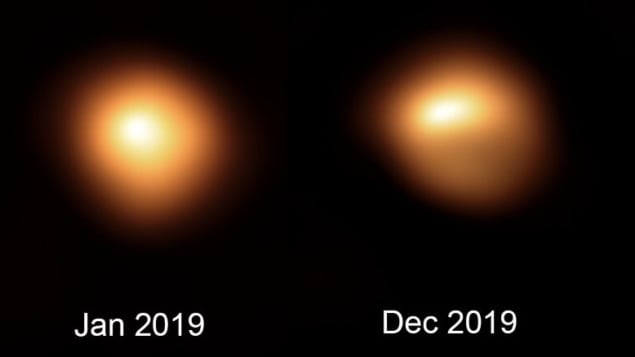Weather satellite sheds light on ‘Great Dimming’ of Betelgeuse star
08 Jun 2022
 |
A weather satellite has helped explain why the red supergiant star Betelgeuse experienced an unprecedented dimming in 2019–2020.
Its findings corroborate earlier studies that concluded the dimming was the consequence of a lower-temperature spot on the star, which reduced the heat going to a nearby gas cloud. This, astronomers believe, allowed the cloud to cool and condense into dust that blocked some of Betelgeuse’s light.
As a variable star, nearby Betelgeuse normally fluctuates in brightness, but in October 2019 it began to grow fainter than had ever been seen before. This led to speculation that it may explode in a supernova. By the end of February 2020, however, Betelgeuse had returned to its normal brightness range, leaving astronomers scratching their heads about what had caused the extreme dip in luminosity.
Rival theories
Two rival theories emerged for the reduction in light. One involves the development of a large convective cell in the star that was cooler (and dimmer) than the rest of Betelgeuse’s surface. The other theory involves the partial obscuration of the star by a dust cloud. However, neither theory on its own could explain the star’s dimming.
Then, in 2021 a team led by Miguel Montargès of the Observatoire de Paris in France proposed, on the basis of observations with the SPHERE (Spectro-Polarimetric High-contrast Exoplanet REsearch) instrument at the Very Large Telescope in Chile, that the dimming involves both a convective cell and obscuring dust.
Now, a group of astronomers and meteorologists, led by Daisuke Taniguchi of the University of Tokyo, has found supporting evidence for this dual explanation – all thanks to the chance observations of a Japanese weather satellite, Himawara-8.
Stellar background
The satellite was launched in 2014 and is in geostationary orbit 35,786 km above the western Pacific. It takes whole-Earth pictures at a multitude of infrared wavelengths, and stars including Betelgeuse are visible in the background.
“Honestly, this project started from Twitter” Taniguchi explains, recalling how he saw a tweet describing how the Moon is visible in the background of images taken by Himawari-8. He and his collaborators then realized that Himawari-8 also had a constant view of Betelgeuse over four years back to 2017.
Himawari-8’s daily observations of Betelgeuse were an advantage over every other telescope, which could only monitor Betelgeuse some of the time. Himawari-8 could even observe the star during the summer, when the star is too close to the Sun for visible wavelength observations. The satellite revealed that the star itself cooled by 140 °C. This was sufficient to reduce irradiative heating to a nearby warm gas cloud, causing the cloud to cool and condense into obscuring dust that is detectable at mid-infrared wavelengths. Taniguchi’s team calculates that both the cooling of the star and the formation of the dust cloud contributed almost equally to what astronomers are referring to as the “Great Dimming”.
“Beautiful result”
“It is really a beautiful result,” says Montargès, who was not involved in this latest research. “The method they use is very original.”
The Himawari-8 observations also suggest that something was happening to the atmospheric structure of Betelgeuse 10 months before the dimming. Water molecules on the star that would normally create absorption lines in the star’s spectrum suddenly changed to form emission lines instead, indicating that something had energized them.
While there is no firm proof for what happened, Taniguchi speculates that “an irregular pulsation might have led to the temperature drop on the star’s surface, and the occurrence of a shockwave that might eject a gas cloud from the star”. This shockwave could have passed through the cloud, instigating the observed transition from absorption to emission of notable spectral lines.
Montargès agrees that this seems to be a reasonable idea. Indeed, he argues that convection cells bubbling up on the star’s surface, called the photosphere, are the only plausible explanation.
Photospheric activity
“The gas cloud can only originate from the photosphere and the only photospheric activity we detect comes from the convection, the powerful motion of the gas,” he says.
It’s too early to tell whether this is normal behaviour for a red supergiant star like Betelgeuse. Montargès alludes to another possible dimming event in the 1940s, but otherwise in over two centuries of monitoring Betelgeuse and other red supergiants, nothing like the Great Dimming has been seen. It may be that such events have happened on other red supergiants, only for us to have missed them because of their relatively short duration.READ MORE

“Before concluding that it is a common behaviour for this class of stars, we need to observe it elsewhere,” says Montargès.
Meanwhile, Taniguchi and colleagues are making full use of Himawari-8 to monitor other stars. They have initiated new projects to make a catalogue of the variability of aged stars in infrared light, as well as searching for new classes of object that are variable at infrared wavelengths.
“All these projects use the same satellite, Himawari-8,” says Taniguchi. “I hope that some other scientists will also start their own projects using Himawari-8 or other weather satellites.”
The research is described in Nature Astronomy.
Keith Cooper is a science writer based in the UK.
from physicsworld.com 13/6/2022
Δεν υπάρχουν σχόλια:
Δημοσίευση σχολίου